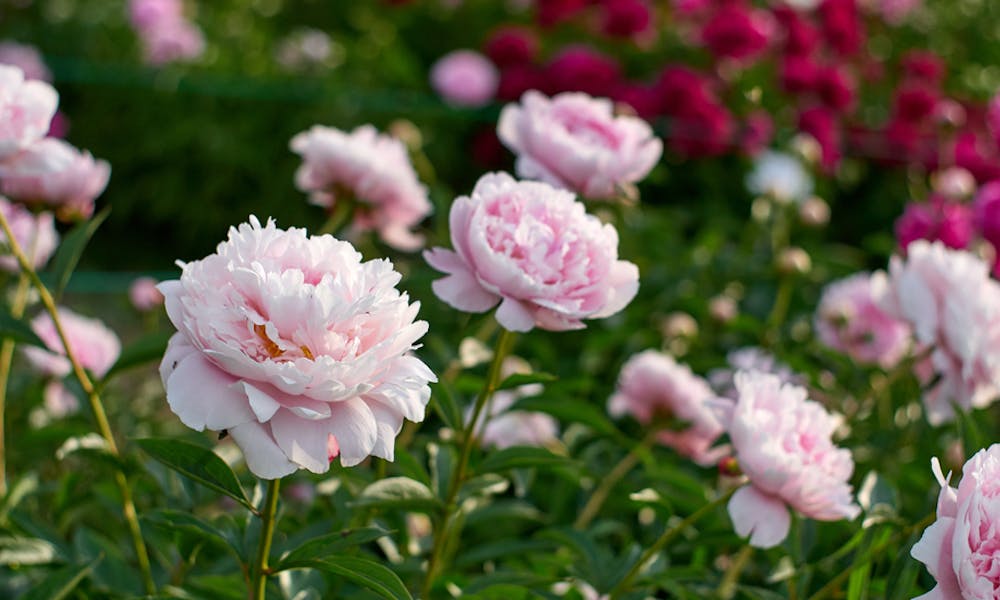The peony is either a herbaceous perennial that form a bunch (China peony), or in bushes or sub-shrubs (shrub peony). Its leaves are constantly deciduous. Slightly capricious, the tree of peony can take two to five years to bloom. It benefits from a good rusticity and its durability is tremendous: the more it ages, the more it blooms.
Elegant, attractive, flamboyant: the peony has everything it takes to be royalty. It catches the eye during its blooming period, and can almost make you forget about the other flowers in the garden.
In this article, we are going to elaborate on the different kinds of peonies, and talking about the peonies season and how to take care of them then, before giving the meaning of this elegant plant. We discuss several points in this article, such as:
* What Are Peonies?
* What Are the Herbaceous Peonies?
* When Is the Peonies Season?
* What Is the Meaning of Peonies?
* How to Plant Peonies?
What Are Peonies
The savage varieties of tree peony, originally from China, are found in the mountains on the border of the ice fields, which makes today’s varieties of tree peony highly resilient to difficult weather conditions, including frost and sun.
The tree forms a bushy shrub with heavy branches, with deeply indented foliage that is green and occasionally shaded purple. Shrub peonies are extremely durable, growing to over 1.5 m in both height and width as they mature.
The blooms, initially single, have produced by repeated selections of semi-double to dual blooms, which range in color scheme from white to dark violet, passing through all nuances of pink and red, and sometimes even yellow and orange.
Depending on the variety and the weather, blooming occurs from the end of March to the very end of May. Certain flowers are nicely scented. Shrub peonies are propagated by transplanting on grass peony roots to nourish the shrub peony.
What Are the Herbaceous Peonies?
Herbaceous peony is a hardy perennial plant that grows for a remarkably extended period (up to 100 years in some cases!) commercialized in the form of a dried bulb. The herbaceous peony wild plants come originally from various areas of the Northern Hemisphere’s moderate regions (North America, Europe, and Asia), and are found in very diverse environments. The present varieties of peonies have excellent adaptability to the conditions in which they are cultivated in the garden.
Herbaceous peony growth appears in the spring until early summer and fades away in late autumn with the first freezes. These trees reach a height of 70 to 100 cm at the point of blooming, which occurs from April to June, according to the species. The blooms are simple, half-double or dual, in variations of white, pink and red, with all the possible middle nuances. The peonies are beautifully scented.
When Is the Peonies Season?
June is peonies’ main flowering period but from early February to the end of June, your specialist florist can provide you a wide range of peonies in his or her boutique. The first peonies come from Israel at the start of spring and are cultivated in greenhouses.
Almost at the same time, the first French peonies come from France (from the greenhouse), and then the French peonies from outdoors, as well as the first ones from the Netherlands. The greenhouse peonies are introduced first, then those from the fields.
Peony season is in full swing between the end of May and mid-June, which also represents the time when gardeners are collecting a maximum number of peonies from the fields.
What Is the Meaning of Peonies?
Peony flower is especially famous for embodying ideas and values. The peony, a flower with noticeably large blossoms, has many meanings in the flower vocabulary. The single peony represents shame or remorse, while the double peony represents bright love. A red peony symbolizes protectiveness in love. White peony is an encouragement for a healthy recovery. A pink peony expresses timid love or a sense of humbleness. People with superstitious beliefs place a bunch of peonies in their homes to drive away evil spirits.
The Chinese peony has a high worth in Chinese culture. This magnificent flower is the symbol of China and is an official emblem of the nation. You can find it at many religious celebrations and traditions. It is the most used flower in oriental culture, during the past but also the present, as a symbol of royalty and pride. The name peony in the Chinese language even means “the most beautiful.”
How to Plant Peonies?
Peonies are tough and durable plants. They can withstand severe winters and warm, dry summers. Your main focus must be on planting it. The soil quality and placement can ensure the growing success of peonies, especially since peonies do not like to be disturbed and take several years to establish themselves properly to flower generously. To begin with, the area must be extremely bright.
As a rule, a sunny spot is best suited for planting it. Space must be large. Peonies develop gradually but safely with age. All types of ground can be appropriate for peonies, as far as they are properly drained. Peonies enjoy fresh soil but are afraid of excess moisture. The soil should be rich in nutrients required to support the abundant flowering of peonies.
The peony is mostly famous with its scientific term “Paeonia.” The peony gets its origin from the figure characterizing the peacock in Greek legend, the student of the medical god Asclepius. It is said that Zeus transformed the student into a lovely flower when he demonstrated more potential than his mentor did. This flower is very resistant, elegant, and well perfumed. In China, its name means “the most beautiful,” and it is a national emblem. There are different varieties of peonies to enjoy during their season, from early March to early June.
